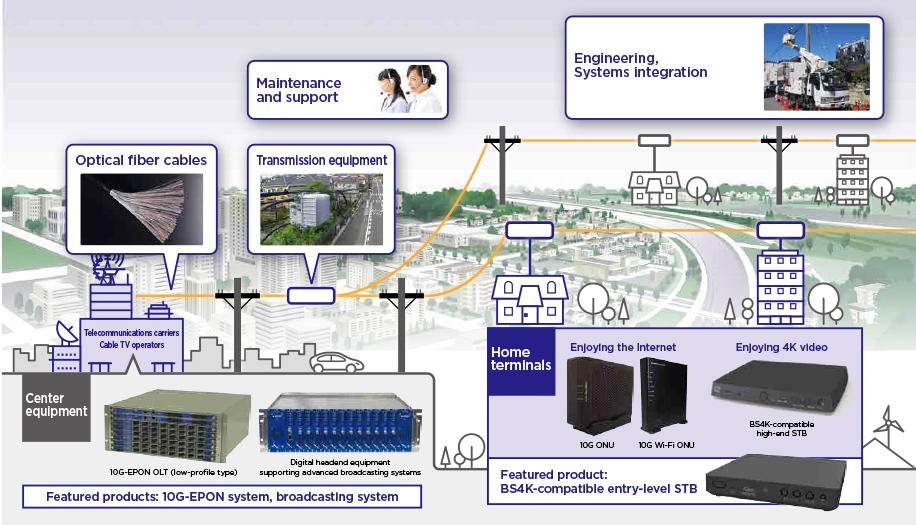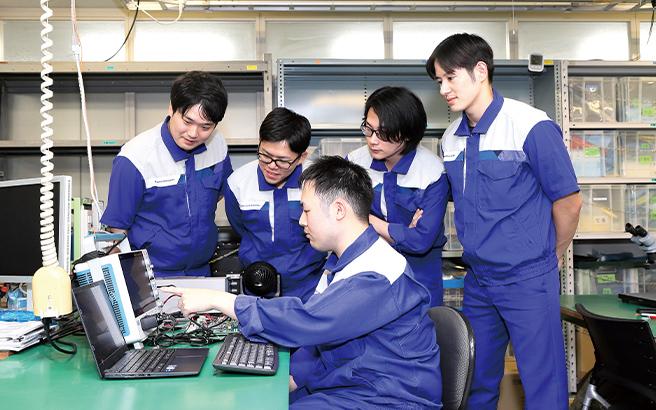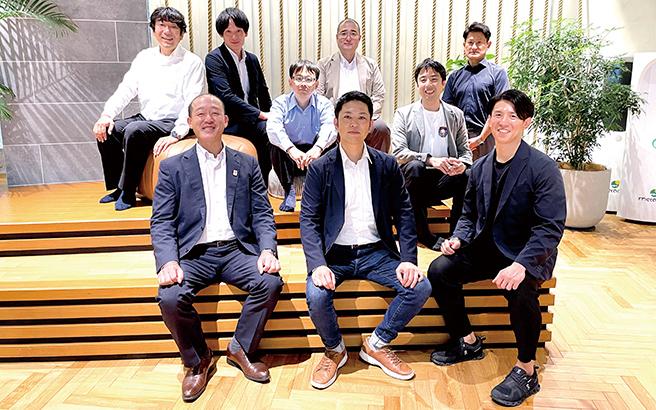
Driving the Evolution of Broadband
Image: family togetherness with broadband networks
Essential Role of Information and Communication Networks in Social Infrastructure
ADSL, the catalyst for the spread of the Internet
The origin of the BNS business dates back to the two-way optical CATV system, Hi-OVIS*1, which began operation in 1978. This was the world’s first attempt to connect ordinary homes and public facilities via optical fiber to enable two-way video communication. The knowledge gained from this project was later applied to the network products business, video products business, and CATV systems business. In the late 1990s, as the Internet spread more widely in homes, the demand for broadband access networks grew. Although ISDN*2 was being developed in Japan, it was not able to keep pace with the increasing richness of content. Efforts to establish FTTH*3 were progressing simultaneously, but full implementation would take time. Sumitomo Electric believed that the advancement of broadband would lead to the creation of new services and content, thereby increasing demand for faster FTTH, and explored technologies to bridge the gap between ISDN and FTTH. Focusing on ADSL*4 technology, the company commercialized ADSL equipment in 1997, leading Japan to the forefront of broadband access worldwide.
Development of GE-PON, the leading technology for FTTH

At that time, Wataru Kida, who is now the General Manager of the Broad Networks Division, was in charge of sales of broadband products, including ADSL.
“We entered the access network market, capitalizing on our pioneering development of ADSL equipment. However, the market was dominated by major telecommunications equipment manufacturers. In the telecommunications industry, we were viewed merely as an electrical wire manufacturer and as a maverick. A major turning point came when we developed GE-PON*5 equipment, using the leading technology for FTTH at the time. We combined the technology we had accumulated in optical LAN, achievements in ADSL, and our technological capabilities as an optical components manufacturer to outcompete major telecommunications equipment manufacturers and secure the top market share. Furthermore, we developed 10G-EPON equipment, which offers 10 times the transmission capacity. We launched it into the market as a platform supporting high-definition video (4K) services and successfully achieved the top market share,” said Kida.
Convergence of communications and broadcasting, moving towards all-IP
The BNS Division was established in 2014 through the partial merger of Sumitomo Electric Networks, Inc., which develops broadband equipment business, and Broad Net Mux Corporation, which operates system integration business for CATV. The division aims to “expand its business in the convergence area of communications and broadcasting” through its comprehensive business of developing, manufacturing, and selling network products and video products for telecommunications carriers, as well as designing, constructing, and maintaining CATV systems. Recent achievements include the all-IP*6 transition of communications and broadcasting. We constructed an IP multicast broadcasting system in an FTTH environment and demonstrated that it was possible to stably provide the same broadcasting service as the RF (radio frequency) system. The transition from RF to IP is anticipated to enable the transmission of high-definition 4K/8K video, the diversification and sophistication of broadcasting services, and the strengthening of networks while improving energy efficiency.
“As a symbol of the shift to IP, in 2008 we developed the world’s first IP-STB*7 compatible with IP retransmission of digital terrestrial television broadcasting, and in 2014, we developed the world’s first IP-STB compatible with commercial 4K services and delivered it to telecommunications carriers. This was a pioneering step towards IP broadcasting services,” said Kida.
Continuing to support evolving networks as social infrastructure
Broadband networks are expected to continue to evolve. For example, broadband networks enable the extended reality (XR) video streaming service, which combines the real and virtual worlds. Development of headmounted displays and XR glasses is also progressing, and new worlds that have never been experienced before are expected to be created.
”I believe that 3D, XR, the metaverse, and other technologies will not only provide entertainment but also contribute positively to society. Broadband networks can improve the convenience and comfort of people’s lives and society, supporting autonomous driving, remote medical care, caregiving services, IoT, as well as generative AI. Networks are an indispensable aspect of social infrastructure, and we have a social responsibility to support them. We aim to continue contributing to the resolution of social issues by achieving networks that are high-speed, high-capacity, lowlatency, and energy-efficient,” said Kida.
In 2024, we celebrated the 10th anniversary of the launch of the BNS Division. The convergence of communications and broadcasting has progressed steadily. In the next chapter, we will explore the strengths of the three business areas within the BNS Division that have supported the convergence.
*1: Highly Interactive Optical Visual Information System: a future-oriented project of the Ministry of International Trade and Industry carried out from 1978 to 1986.
*2: Integrated Services Digital Network: a communication method that uses telephone lines to transmit digital signals for telephone and data communications.
*3: Fiber To The Home: a connecting method that connects the service providers’ facilities to each home using optical fiber.
*4: Asymmetric Digital Subscriber Line: a digital data communications technology that enables high-speed Internet communications using regular analog telephone lines.
*5: Gigabit Ethernet Passive Optical Network: a high-speed optical access method that uses optical fiber.
*6: Internet Protocol: a communication protocol that governs data exchange over the Internet.
*7: Set-Top Box: a terminal that receives broadcast signals and provides video content to a home TV.

NEXT
Three Areas Supporting Communications and Broadcasting
- Their Strengths, Strategies, and Outlook -
Registration of public notification
If you register your e-mail address, we will notify you when the latest issue is published. If you wish, please register from the registration form.
To delete your registration, please visit here.




